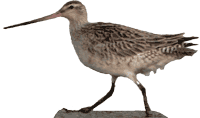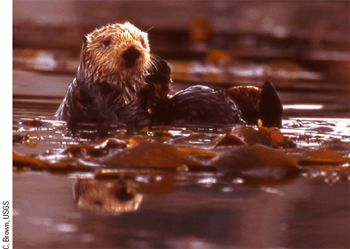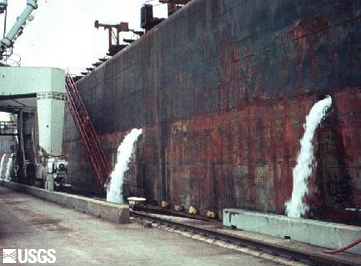- Home
- About S&T
- Taxa/Organisms
- Ecosystems
- Issues
- Methods & Tools
- Reports & Publications
- Location
- Search
October 2008 | Publisher: USGS (Soundwaves) | Format: URL
soundwaves.usgs.gov — Three years after Hurricanes Katrina and Rita ravaged the U.S. Gulf Coast, the region was hit once again by a pair of large storms: Hurricane Gustav made landfall near Cocodrie, Louisiana, on September 1, 2008, as a strong Category 2 storm; and Hurricane Ike made landfall near Galveston, Texas, on September 13, 2008, also as a strong Category 2 More...

2008 | Publisher: USGS | Format: URL
soundwaves.usgs.gov — U.S. Geological Survey (USGS)'s Western Region held an internal USGS workshop on Sea-Level-Rise Impacts on November 6-7, 2007, in Menlo Park, California. The meeting was attended by 30 scientists from four USGS disciplines (geology, geography, biology, and water) and 13 different science centers in the Western Region. In part a follow-up to the More...

February 2006 | Publisher: USGS | Science Center: Pacific Island Ecosystems Research Center (PIERC, Honolulu) | Format: .PDF
biology.usgs.gov — A success story of how Kanaha Beach Park once degraded with overuse, invasive species, vehicle traffic, and litter was restored into a cleaner and safer place for people and native wildlife.

Publisher: USGS | Science Center: Florida Integrated Science Center (FISC, Gainesville) | Format: URL
fl.biology.usgs.gov — This web resource is a species profile and checklist for the Scleria lacustris (Wright's nut-rush), which is an invasive plant, which spreads in seasonal marshes of Florida. The site gives an introduction to the plant, along with identification tips with images of the weed.

Publisher: USGS (Coastal and Marine Geology Program, Eastern Region) | Format: URL
coastal.er.usgs.gov — One purpose of the USGS National Assessment of Coastal Change Project is to provide accurate representations of pre-storm ground conditions for areas that are designated high-priority because they have dense populations or valuable resources that are at potential risk from storm waves. Another purpose of the project is to develop a broad More...

Publisher: USGS | Science Center: Alaska Science Center (ASC, Anchorage) | Format: URL
alaska.usgs.gov — It is estimated that 100,000-150,000 Bar-tailed Godwits breed in Alaska. Under the US Shorebird Conservation Plan, they are a species of High Concern mainly due to their small population size, threats to their non-breeding grounds (especially at migratory stopover sites in Asia), and their relatively restricted breeding distribution within the More...

Publisher: USGS | Science Center: Alaska Science Center (ASC, Anchorage) | Format: URL
alaska.usgs.gov — Rock Sandpipers are a species unique to the north Pacific, with breeding populations found in near-shore habitats ringing the Bering Sea (Gill et al. 2002). Likely numbering fewer than 100,000 individuals and with at least 4 recognized subspecies, this robin-sized shorebird displays physiological feats of wonder by virtue of its being the More...

Publisher: USGS | Science Center: Western Ecological Research Center (WERC, Sacramento) | Format: URL
www.werc.usgs.gov — Sea otters (Enhydra lutris) are keystone predators in the nearshore environment of the eastern Pacific Ocean, in a food web composed of sea otter, sea urchin, and kelp forest. Without sea otters, the kelp forest can be overgrazed by sea urchins, which in turn can affect other species that depend on this ecosystem. This resource provides links to More...

Publisher: USGS | Format: URL
pubs.er.usgs.gov — This report presents the results of the 2006 International Census of Piping Plovers (Charadrius melodus). Two sets of tabular data are reported: one for distribution and abundance of wintering Piping Plovers, the other for distribution and abundance of breeding Piping Plovers. The winter census resulted in the observation of 3,884 Piping Plovers More...

Publisher: USGS | Science Center: Florida Integrated Science Center (FISC, Gainesville) | Format: URL
fl.biology.usgs.gov — Because the African jewelfish has a broad salinity tolerance, scientists tested how the species low-temperature tolerance varied at three salinities: freshwater (0 ppt), brackish (10 ppt) and marine (35 ppt) in the laboratory. A field experiment was then conducted to examine the survivorship of individuals when caged in several common aquatic More...

Publisher: USGS | Science Center: Western Fisheries Research Center (WFRC, Seattle) | Format: URL
wfrc.usgs.gov — Ballast water discharges are the most significant cause of aquatic biological invasions in coastal waters, including the Great Lakes. Currently, treatment of ballast water prior to discharge at the receiving port offers significant promise to help control this problem. However, development of treatment technologies is limited by lack of objective More...

Publisher: USGS | Science Center: Florida Integrated Science Center (FISC, Gainesville) | Format: URL
fl.biology.usgs.gov — This webpage is a species profile and nonindigenous species information bulletin of the Asian shore crab, Japanese shore crab, Pacific crab, Hemigrapsus sanguineus (De Haan)(Arthropoda: Grapsidae), with information on its identification and native range, life history, habitat, nonindigenous occurrences, means of introduction, its environmental More...
